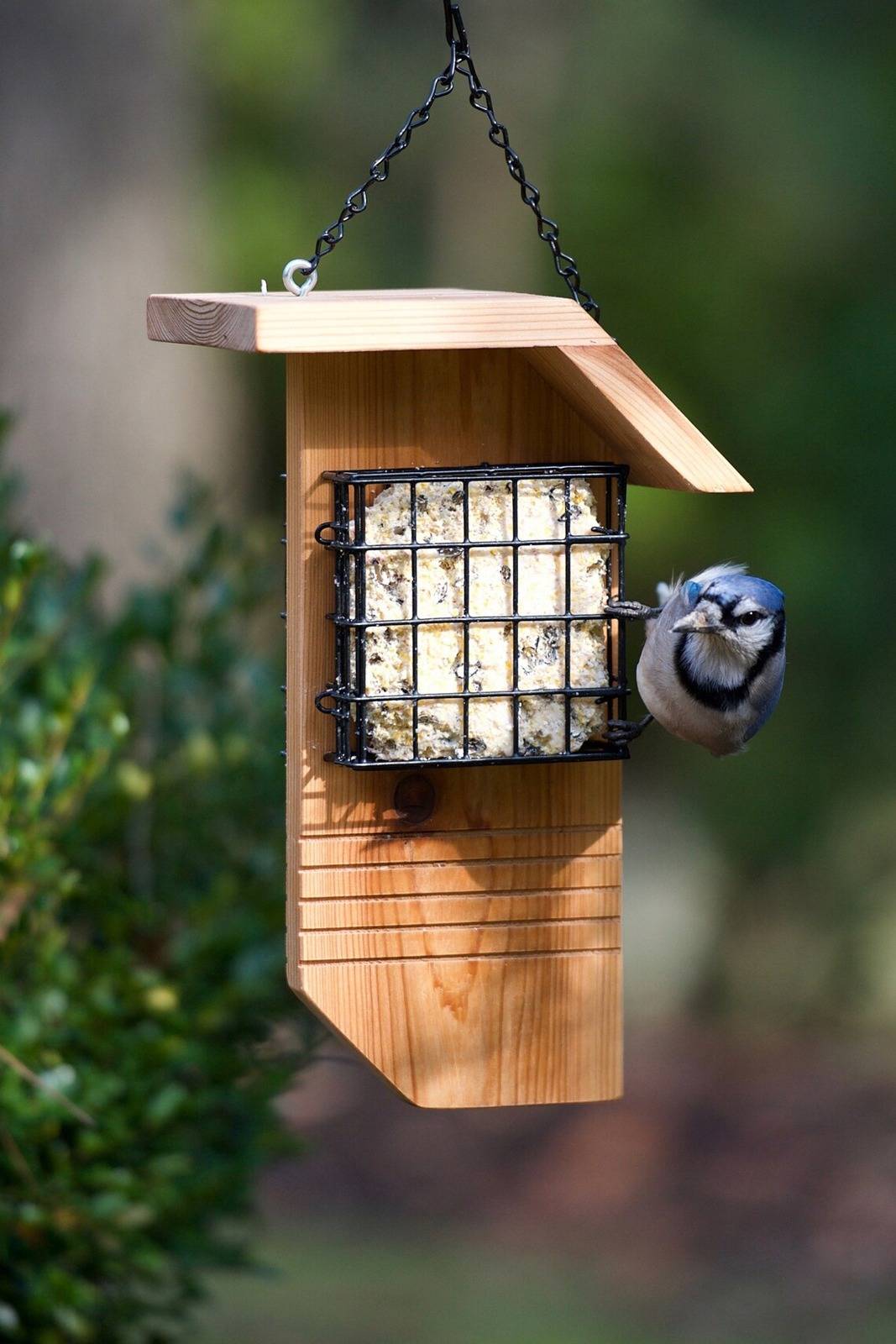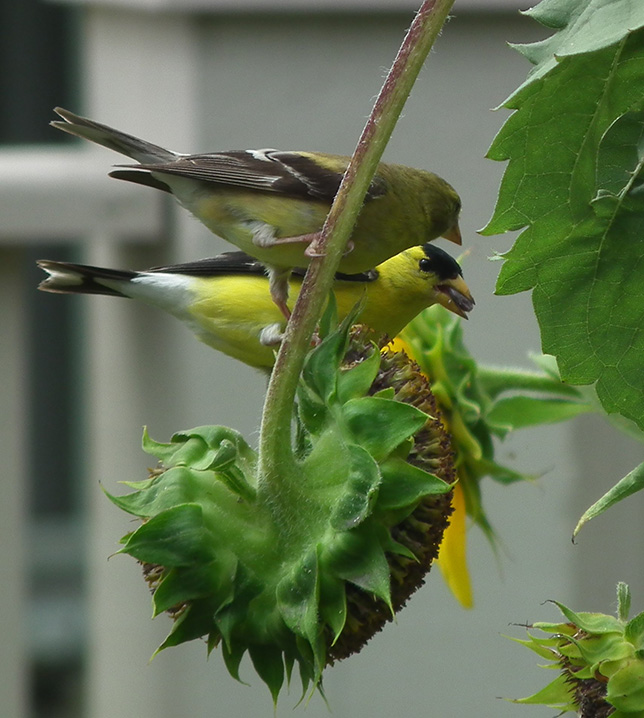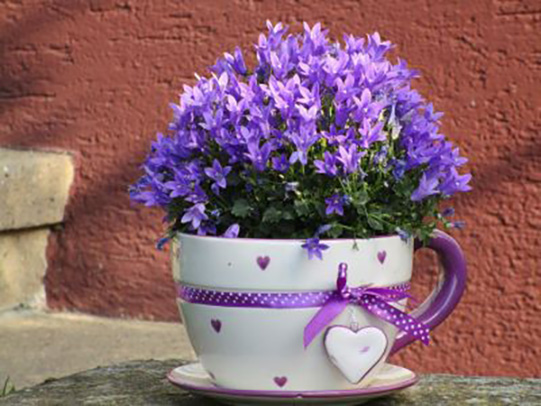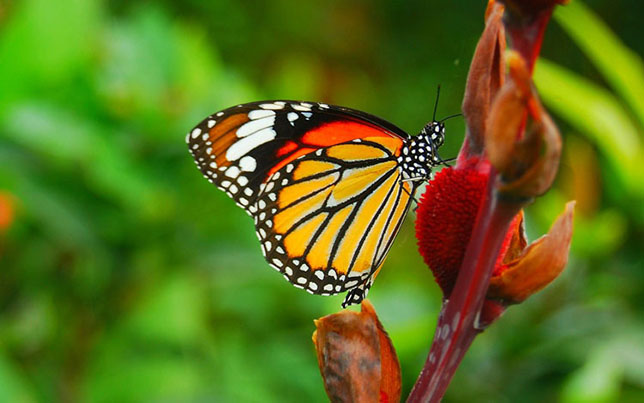Feeding wild birds in winter can aid their survival, in addition to providing humans with entertainment and a great learning opportunity for young and old alike. The presence of wild birds in the winter landscape adds life and interest that can bring an entirely new aspect to the season for gardeners.

Feeding Wild Birds in Winter
Why Feed Wild Birds in Winter?
Winters, especially when they are severe, can be hard for wild birds. The food sources that were plentiful in the spring and summer have either died or gone dormant. Snow may periodically cover the ground hiding potential food sources, and their water supply is often frozen. Birds given high quality, high-fat foods in the winter to help them generate enough body heat have a better chance of survival.
If you enjoy birdwatching from the comfort of your living room, feeding wild birds in winter will also benefit you, giving you a chance to view different species than those you might find at other times of the year. To increase the number of species you attract you can offer varied types of food in several styles of feeders that will accommodate their different feeding habits.
What's best to feed wild birds in winter?
- Depending on the species, the preferred food may vary, but most birds do like black oil sunflower seeds. These are not the same as the ones you get at a baseball game. They have a thinner shell, are easier for birds to open, and have higher oil content. While more expensive, hulled sunflower seeds or seed chips might even be better in winter since the birds don’t have to expend the energy opening the seeds. Another benefit of the hulled seeds is there is less chance that they will be lost and eventually germinate, and the lack of hulls keeps the area beneath the feeder cleaner. They should be protected from water and moisture though because they will spoil more quickly. Seeds can be offered in a tube, platform, or hopper feeder.
- Suet is another option for feeding. Suet is beef fat that has been rendered down. You can do this yourself or you can purchase suet cakes specifically for birds. These are often incorporated with seeds or other goodies that birds like. Homemade suet is best used during the colder months because it can melt in warm weather and go rancid. Commercially prepared suet is available in "no-melt" formulas that can be used year-round in most climates. Suet is most often offered in special suet feeders with a metal cage. To attract larger species of woodpecker to your feeder you can choose a model with a tail prop. Woodpeckers are cling feeders, resting their tails on trees for support. A feeder with a tail prop simulates their natural environment, allowing larger birds to access the feeder comfortably. You'll certainly remember the day a pileated woodpecker first visits you--have that camera ready!!
- Peanuts are a third option due to their high fat content. They won’t freeze in the winter so you can offer them whole or shelled. These will likely attract larger birds like blue jays and red-bellied woodpeckers. If you feed peanuts from a large platform feeder, hopper feeder, or on the open ground you may attract crows as well. If that's something you might not enjoy you can use hanging feeders without any large perching opportunities. If you don't want squirrels cacheing the nuts everywhere you might want to forego this option--they can wreak havoc in a garden, first burying and later retrieving their booty from newly planted pots and planters or freshly mulched beds.
- Peanut butter is option which birds seem to like, too. Choose a brand with as little added salt and sugar as possible. It can be spread on pine cones which can then be rolled in bird seed and hung from branches--a great winter activity for the kids! It can also be mixed with corn meal and/or oatmeal and plugged into a suet log feeder, or make one yourself by drilling 1-1/2 to 2 inch wide holes through a log and screwing a metal eye hook into the top. You don't have to drill the holes all the way through, but it will make it easier to clean.
- Smaller birds like finches and pine siskins seem to prefer Nyjer seed. A plus about Nyjer is that it is treated to prevent germination if spilled on the ground. It doesn't seem to store as well as other seed, though, and I've found it much more susceptible to spoilage in the feeder if not protected from rain. For this reason, and since it tends to be more expensive than other types of seed, you might want to purchase and feed in small amounts to start.
- Fruit is also a food most birds love. Apple or banana slices, oranges, melon, grapes, and dried fruit can all be put out for birds. Dried fruit can also be added to suet for a tasty treat. Some birds may prefer the dried fruit after it has soaked overnight--this also provides extra water for them. You can spear fruit directly on sharp twigs of bushes or place it in a suet cage or on a platform feeder. To prevent a moldy mess, don't place fruit in plastic tube or hopper feeders where it's not exposed to air circulation.
- Mealworms are great for attracting insect-eating birds like wrens, bluebirds, and even robins. Dried mealworms can be offered in small amounts on platform feeders or in small cups or dishes. Sometimes soaking them a bit makes them more tempting if it seems the birds are interested yet. If you really want to go there, live mealworms can be purchased. These are usually kept in a container of oatmeal in the refrigerator to keep the larvae from hatching. Since wriggling larvae in the refrigerator is something most of us choose to avoid, you might want to try the dried ones first!
- Safflower seed is known to be a favorite of cardinals, and is also appreciated by many other birds including doves and finches. The advantage to safflower is that it is less attractive to (most) squirrels and nuisance bird species such as starlings and grackles, due to its bitter flavor. As birds will still usually prefer the black oil sunflower, feeding both may be unadvisable to avoid wasted seed.
Below: One of the more colorful birds of winter, blue jays are especially attracted to peanuts, suet, or sunflower seeds offered in stable platform or hopper feeders

Below: Many insect-eating birds, like this Carolina Wren, will be tempted by feeders filled with suet, sunflower seeds, or mealworms in winter.


Below: Red bellied woodpeckers are easy to attract to feeders in winter, whether filled with sunflower seeds, peanuts, or suet. Despite the bright red nape on this female, this bird is so named for the very pale rose to buffy wash on the belly. Males of this species have red crown feathers as well. The red-headed woodpecker is an entirely different species whose numbers have taken a precipitous decline in recent decades.

What type of feeder do wild birds prefer?
- Tube Feeders can be made with multiple ports with perches at different levels, or created from a metal mesh that birds can cling to all the way around. Birds such as cardinals that need a perch to land on won't be able to use the mesh tubes, but woodpeckers, nuthatches and finches will have no problem. Mesh tubes with larger gauge holes can be used for peanuts that don't fit in other styles of tube feeders. Tube feeders are more difficult to clean than most hopper or platform feeders.
- Hopper Feeders have a short platform where birds can perch while accessing the seed. They are accessible for bigger birds like cardinals, grosbeaks, blue jays, and possibly doves if large enough, but will be used by most birds. The advantage to hopper feeders is their generally larger capacity so there's less frequent refilling. They can be made of wood, plastic, or metal, and are usually fairly easy to maintain. Our Victorian and Chapel feeders are ideal, with a combination of a hopper, platform, and roof to accommodate more bird species and keep the seed dry.
- Platform Feeders are open, flat trays that allow more comfortable feeding for birds like doves that find it difficult to use other types of feeders. Some have short legs to accommodate placement near the ground, others can be placed on poles or hung. Virtually any bird that will fit on the platform will use it, which is good. That unfortunately includes a lot of "nuisance" birds like starlings, grackles, and pigeons (and squirrels) which can overwhelm these feeders, discouraging other more timid species. And your seed gets eaten pretty quick! They are easy to clean, but large ones may get dirtier since birds don't go off to the powder room during meals.
- Feeders may be specialized for various foods. Suet feeders are usually hanging metal cages or log-shaped with large holes. Thistle socks are fine mesh fabric with a drawstring at the top that is used for feeding Nyjer seed. Hanging round spiral metal frames can hold corn cobs or peanuts in the shell.
No matter what, you should choose a feeder to invite the types of birds you will enjoy and is easy enough for you to refill and keep clean.
Where should wild bird feeders be placed?
- It's a good idea to have some type of cover nearby to which birds can escape should they feel threatened, such as evergreen shrubs or trees or very twiggy deciduous shrubs. Try to have the feeder stationed beyond cat-leaping distance but close enough that the birds can reach cover quickly--about 10 feet is usually a safe distance.
- Feeders that are hung or on a pole should be at least 5 feet from the ground, and no higher than you can easily reach to refill and clean them. Platform feeders for ground-feeding birds should be placed on or near the ground.
- To prevent collisions with large windows it's recommended to place your feeder no farther than 3 feet away, and the closer the better. That way, the bird will have a better chance of surviving a strike as it won't have had time to gain speed if it heads for the glass after taking off from the feeder. Even without bird feeders, if your home has large picture windows or other areas of reflective surfaces you may need to look into window decals and other products available to reduce collisions.
How to keep squirrels away from bird feeders?
If you're using a feeder on a pole, you'll need some other solution, and sometimes a combination of more than one. Baffles can block access from both above and below when properly installed. Hot pepper coated seed is available, and is unpalatable to squirrels but doesn't bother the birds.
Squirrel-deterrent feeders are probably the best option. Most of these use a spring device activated by the weight of the squirrel to close the feeding ports, so keep them away from anything the little rodents could hang or sit on and lean over to the OPEN ports. Some of these feeders are adjustable as to the allowed weight so that larger birds like starlings can go unfed as well. Other feeders are enclosed by a metal mesh cage with openings large enough to permit access for smaller birds but too small for squirrels and starlings to easily reach the seed.
You can also offer them their own food supply so they'll leave your feeders alone, or at least raid them less often. The other option is to just enjoy their antics!
How should wild bird seed be stored?
For this reason, seed is best stored outside in a cool, shady spot. Galvanized metal trashcans with tight-fitting lids to exclude animals are excellent for this purpose. If you still have a problem with the moths that bothers you, you can attach a moth trap on the inside lid of the storage container. These use phereomones to attract the moths and will not harm the birds or damage the seed.
What Birds Come to Feeders in Winter?
- Winter feeder birds I see regularly (almost daily) in Maryland : Cardinal, dark-eyed junco, Carolina wren, tufted titmouse, Carolina chickadee, house finch, purple finch, downy woodpecker, white-throated sparrow, starling, house sparrow, mourning dove, blue jay, red-bellied woodpecker, white-breasted nuthatch, crow
- I have seen on occasion seen these birds as well: Song sparrow, Eastern bluebird, American goldfinch, brown creeper, rusty towhee, mockingbird, red-winged blackbird, pine warbler, yellow-rumped warbler, chipping sparrow, hermit thrush
- Check Cornell University's Project Feeder Watch "Common Feeder Birds" page for an interactive listing of 100 species with regions, seasons, feeders, and preferred foods. If you want to get more involved, you also can join their feeder bird count!
A few final winter bird feeding tips:
- To attract a wide variety of birds, consider offering different foods from different types of feeders. Over time you’ll learn what your backyard birds like best.
- To prevent disease, clean your feeder often (every two weeks) and disinfect it with 1 part bleach to 9 parts water. Also clear away the seed hulls left behind.
Is it safe to feed wild birds?
Some wonder about the ecological impacts of feeding wild birds. According to the US Fish and Wildlife Service, it does appear that ranges of some birds, such as Carolina wrens and cardinals, may have been at least in part expanded by the availability of feeders. Most studies report positive effects on both winter survival rates and reproductive success, but there are two UK studies of the blue tit that show a negative impact on egg-laying, hatching, and fledgling survival rates. Those studies could not confirm the reason, but possible suggested causes included a too fat-rich diet, encouraging nesting in poor habitat near the feeders resulting in increase predation, and perhaps increased breeding by individuals with otherwise poor reproductive capacity. On the whole, feeding seems to have a postive effect according to Cornell University's Project Feeder Watch:
"If supplemental feeding is ecologically detrimental, then we would expect to see long-term population declines in the species that consume the most supplemental food." However, "overall, species that utilize bird feeders the most were doing better over time, rather than worse, and the few species showing declines include non-native species (House Sparrow, European Starling)..."
Learn More:
- August 24, 2016 Project Feeder Watch Blog: The impacts of supplemental feeding on bird populations
- The Nature Conservancy Cool Green Science Blog January 2015: Winter Bird Feeding - Good or Bad for Birds?
- Cornell Lab All About Birds News January 3, 2025: Avian Influenza Outbreak - Should You Take Down Your Birdfeeders?
- USDA Animal and PlantHealth Inpection Service January 28, 2025: Detections of Highly Pathogenic Avian Influenza in Wild Birds
- US Centers for Disease Control and Prevention (CDC): Topic Page on Avian Influenza (Bird Flu) in Humans











